Efficient Pervaporation for Ethanol Dehydration: Ultrasonic Spraying Preparation of Polyvinyl Alcohol (PVA)/Ti3C2Tx Nanosheet Mixed Matrix Membranes
Abstract
1. Introduction
2. Experimental Section
2.1. Materials
2.2. Preparation of Ti3C2Tx-Based MXene Nanosheets
2.3. Preparation of the Composite Membranes
2.4. Characterization of the Membrane
2.5. Swelling Degree of the Membrane
2.6. Tensile Property Test of the Membrane
2.7. Pervaporization (PV) Performance Measurement
2.8. Hansen Solubility Parameters
3. Results and Discussion
3.1. Microstructure and Chemical Structure
3.2. Thermal and Mechanical Stability
3.3. Pervaporation Experiment
4. Conclusions
Supplementary Materials
Author Contributions
Funding
Institutional Review Board Statement
Data Availability Statement
Acknowledgments
Conflicts of Interest
Abbreviations
| AAO | Anodic aluminum oxide |
| AR | Analytical reagent |
| COFs | Covalent organic frameworks |
| CS | Chitosan |
| 2D | Two-dimensional |
| DI | Deionized |
| DSC | Differential scanning calorimetry |
| EDX | Energy dispersive X-ray detector |
| FESEM | Field emission surface scanning electron microscope |
| FTIR | Fourier transform infrared spectroscopy |
| GC | Glycerol |
| GO | Graphene oxide |
| MMMs | Mixed matrix membranes |
| MOFs | Metal organic frameworks |
| PTFE | Poly(tetrafluoroethylene) |
| PV | Pervaporation |
| PVA | Polyvinyl alcohol |
| SA | Sodium alginate |
| SD | Swelling degree |
| SEM | Scanning electron microscope |
| TG | Thermogravimetry |
| UTM | Universal testing machine |
| WCA | Water contact angle |
| XRD | X-ray diffraction |
| XPS | X-ray photoelectron spectroscopy |
References
- Kumar, S.; Singh, N.; Prasad, R. Anhydrous ethanol: A renewable source of energy. Renew. Sustain. Energy Rev. 2010, 14, 1830–1844. [Google Scholar] [CrossRef]
- Cardona, C.A.; Sánchez, Ó.J. Fuel ethanol production: Process design trends and integration opportunities. Bioresour. Technol. 2007, 98, 2415–2457. [Google Scholar] [CrossRef] [PubMed]
- Srivastava, N.; Rawat, R.; Singh Oberoi, H.; Ramteke, P.W. A Review on fuel ethanol production from lignocellulosic biomass. Int. J. Green Energy 2015, 12, 949–960. [Google Scholar] [CrossRef]
- Bolto, B.; Hoang, M.; Xie, Z. A review of membrane selection for the dehydration of aqueous ethanol by pervaporation. Chem. Eng. Process. 2011, 50, 227–235. [Google Scholar] [CrossRef]
- Liu, G.; Wei, W.; Jin, W. Pervaporation membranes for biobutanol production. ACS Sustain. Chem. Eng. 2014, 2, 546–560. [Google Scholar] [CrossRef]
- Kober, P.A. Pervaporation, perstillation and percrystallization. J. Am. Chem. Soc. 1917, 39, 944–948. [Google Scholar] [CrossRef]
- Neto, J.M.; Pinho, M.N. Mass transfer modelling for solvent dehydration by pervaporation. Sep. Purif. Technol. 2000, 18, 151–161. [Google Scholar] [CrossRef]
- Shaban, H.I. Pervaporation separation of water from organic mixtures. Sep. Purif. Technol. 1997, 11, 119–126. [Google Scholar] [CrossRef]
- Anjali Devi, D.; Smitha, B.; Sridhar, S.; Aminabhavi, T.M. Pervaporation separation of isopropanol/water mixtures through crosslinked chitosan membranes. J. Membr. Sci. 2005, 262, 91–99. [Google Scholar] [CrossRef]
- Chen, J.H.; Liu, Q.L.; Zhu, A.M.; Zhang, Q.G. Dehydration of acetic acid by pervaporation using SPEK-C/PVA blend membranes. J. Membr. Sci. 2008, 320, 416–422. [Google Scholar] [CrossRef]
- Dudek, G.; Turczyn, R.; Gnus, M.; Konieczny, K. Pervaporative dehydration of ethanol/water mixture through hybrid alginate membranes with ferroferic oxide nanoparticles. Sep. Purif. Technol. 2018, 193, 398–407. [Google Scholar] [CrossRef]
- Choudhury, S.; Ray, S.K. Filled copolymer membranes for pervaporative dehydration of ethanol-water mixture. Sep. Purif. Technol. 2017, 179, 335–348. [Google Scholar] [CrossRef]
- Doguparthy, S. Pervaporation of aqueous alcohol mixtures through a photopolymerised composite membrane. J. Membr. Sci. 2001, 185, 201–205. [Google Scholar] [CrossRef]
- da Silva, D.; Zuge, L.C.B.; de Paula, S.A. Preparation and characterization of a novel green silica/PVA membrane for water desalination by pervaporation. Sep. Purif. Technol. 2020, 247, 116852. [Google Scholar] [CrossRef]
- Lu, Q.; Li, N.; Zhang, X. Supramolecular recognition PVDF/PVA ultrafiltration membrane for rapid removing aromatic compounds from water. Chem. Eng. J. 2022, 436, 132889. [Google Scholar] [CrossRef]
- Cheng, P.I.; Hong, P.D.; Lee, K.R.; Lai, J.Y.; Tsai, Y.L. High permselectivity of networked PVA/GA/CS-Ag membrane for dehydration of isopropanol. J. Membr. Sci. 2018, 564, 926–934. [Google Scholar] [CrossRef]
- Khoonsap, S.; Supanchaiyamat, N.; Hunt, A.J.; Klinsrisuk, S.; Amnuaypanich, S. Improving water selectivity of poly (vinyl alcohol) (PVA)-fumed silica (FS) nanocomposite membranes by grafting of poly (2-hydroxyethyl methacrylate) (PHEMA) on fumed silica particles. Chem. Eng. Sci. 2015, 122, 373–383. [Google Scholar] [CrossRef]
- Geim, A.K.; Novoselov, K.S. The rise of graphene. Nat. Mater. 2007, 6, 183–191. [Google Scholar] [CrossRef]
- Zhu, Y.; Murali, S.; Cai, W.; Li, X.; Suk, J.W.; Potts, J.R.; Ruoff, R.S. Graphene and graphene oxide: Synthesis, properties, and applications. Adv. Mater. 2010, 22, 3906–3924. [Google Scholar] [CrossRef] [PubMed]
- Wang, J.; Li, M.; Zhou, S.; Xue, A.; Zhang, Y.; Zhao, Y.; Zhong, J.; Zhang, Q. Graphitic carbon nitride nanosheets embedded in poly(vinyl alcohol) nanocomposite membranes for ethanol dehydration via pervaporation. Sep. Purif. Technol. 2017, 188, 24–37. [Google Scholar] [CrossRef]
- Wang, Y.; Li, L.; Wei, Y.; Xue, J.; Chen, H.; Ding, L.; Caro, J.; Wang, H. Water transport with ultralow friction through partially exfoliated g-C3N4 nanosheet membranes with self-supporting spacers. Angew. Chem. Int. Ed. 2017, 56, 8974–8980. [Google Scholar] [CrossRef] [PubMed]
- Kasik, A.; Lin, Y.S. Organic solvent pervaporation properties of MOF-5 membranes. Sep. Purif. Technol. 2014, 121, 38–45. [Google Scholar] [CrossRef]
- Mak, K.F.; Lee, C.; Hone, J.; Shan, J.; Heinz, T.F. Atomically thin MoS2: A new direct-gap semiconductor. Phys. Rev. Lett. 2010, 105, 666. [Google Scholar] [CrossRef]
- Naguib, M.; Kurtoglu, M.; Presser, V.; Lu, J.; Niu, J.; Heon, M.; Hultman, L.; Gogotsi, Y.; Barsoum, M.W. Two-dimensional nanocrystals produced by exfoliation of Ti3AlC2. Adv. Mater. 2011, 23, 4248–4253. [Google Scholar] [CrossRef]
- Urbankowski, P.; Anasori, B.; Makaryan, T.; Er, D.; Kota, S.; Walsh, P.L.; Zhao, M.; Shenoy, V.B.; Barsoum, M.W.; Gogotsi, Y. Synthesis of two-dimensional titanium nitride Ti4N3 (MXene). Nanoscale 2016, 8, 11385–11391. [Google Scholar] [CrossRef]
- Yang, G.; Xie, Z.; Thornton, A.W.; Thornton, A.W.; Doherty, C.M.; Ding, M.; Xu, H.; Cran, M.; Ng, D.; Gray, S. Ultrathin poly (vinyl alcohol)/MXene nanofilm composite membrane with facile intrusion-free construction for pervaporative separations. J. Membr. Sci. 2020, 614, 118490. [Google Scholar] [CrossRef]
- Cai, W.; Cheng, X.; Chen, X.; Li, J.; Pei, J. Poly(vinyl alcohol)-modified membranes by Ti3C2Tx for ethanol dehydration via pervaporation. ACS Omega 2020, 5, 6277–6287. [Google Scholar] [CrossRef] [PubMed]
- Xu, Z.; Liu, G.; Ye, H.; Jin, W.; Cui, Z. Two-dimensional MXene incorporated chitosan mixed-matrix membranes for efficient solvent dehydration. J. Membr. Sci. 2018, 563, 625–632. [Google Scholar] [CrossRef]
- Li, S.; Geng, X.; Ma, C.; Zhan, X.; Li, J.; Ma, M.; He, J.; Wang, L. Improved performance of three-component structure mixed membrane for pervaporation modified by lignosulfonates@2D-MXene. Sep. Purif. Technol. 2021, 276, 119294. [Google Scholar] [CrossRef]
- Liu, Q.; Pan, X.; Xu, N.; Wang, Q.; Qu, S.; Wang, W.; Fan, L.; Dong, Q. Hypergravity field induced self-assembly of 2D MXene in polyvinyl alcohol (PVA) membrane matrix and its improvement of alcohol/water pervaporation. J. Appl. Polym. Sci. 2023, 140, e53740. [Google Scholar] [CrossRef]
- Shi, Y.; Xiong, D.; Liu, Y. Swelling, mechanical and friction properties of PVA/PVP hydrogels after swelling in osmotic pressure solution. Mater. Sci. Eng. C 2016, 65, 172–180. [Google Scholar] [CrossRef]
- Shi, C.; Liu, T.; Chen, W.; Cui, F.; Liu, L.; Cai, Y.; Li, Y. Interaction, structure and tensile property of swollen Nafion® membranes. Polymer 2021, 213, 123224. [Google Scholar] [CrossRef]
- Wang, K.; Abdalla, A.A.; Khaleel, M.A.; Hilal, N.; Khraisheh, M.K. Mechanical properties of water desalination and wastewater treatment membranes. Desalination 2017, 401, 190–205. [Google Scholar] [CrossRef]
- Huang, R.Y.M.; Yeom, C.K. Pervaporation separation of aqueous mixtures using crosslinked polyvinyl alcohol membranes. III. Permeation of acetic acid-water mixtures. J. Membr. Sci. 1991, 58, 33–47. [Google Scholar] [CrossRef]
- Hansen, C.M. Solubility Parameters: A User’s Handbook, 2nd ed.; CRC Press: Boca Raton, FL, USA, 2007. [Google Scholar]
- Xu, N.; Chen, S.; Li, Y.; Jiang, N.; Zheng, T.; Goossens, N.; Vleugels, J.; Zhang, D.; Seveno, D. A hybrid 1D/2D coating strategy with MXene and CNT towards the interfacial reinforcement of carbon fiber/poly(ether ether ketone) composite. Compos. Part B 2022, 246, 110278. [Google Scholar] [CrossRef]
- Zhang, J.; Wang, H.; Li, W.; Zhang, J.; Lu, D.; Yan, W.; Xiang, Y.; Lu, S. Effect of catalyst layer microstructures on performance and stability for high temperature polymer electrolyte membrane fuel cells. J. Power Sources 2021, 505, 230059. [Google Scholar] [CrossRef]
- Haq, Y.U.; Ullah, R.; Mazhar, S.; Khattak, R.; Qarni, A.A.; Haq, Z.U.; Amin, S. Synthesis and characterization of 2D MXene: Device fabrication for humidity sensing. J. Sci.-Adv. Mater. Dev. 2022, 7, 100390. [Google Scholar] [CrossRef]
- Zhao, L.; Wang, L.; Zheng, Y.; Zhao, S.; Wei, W.; Zhang, D.; Fu, X.; Jiang, K.; Shen, G.; Han, W. Highly-stable polymer-crosslinked 2D MXene-based flexible biocompatible electronic skin for in vivo biomonitoring. Nano Energy 2021, 84, 105921. [Google Scholar] [CrossRef]
- Liu, R.; Li, W. High-thermal-stability and high-thermal-conductivity Ti3C2Tx MXene/poly(vinyl alcohol) (PVA) composites. ACS Omega 2018, 3, 2609–2617. [Google Scholar] [CrossRef]
- Azhar, O.; Jahan, Z.; Sher, F.; Niazi, M.B.K.; Kakar, S.J.; Shahid, M. Cellulose acetate-polyvinyl alcohol blend hemodialysis membranes integrated with dialysis performance and high biocompatibility. Mater. Sci. Eng. C 2021, 126, 112127. [Google Scholar] [CrossRef]
- Wu, G.M.; Lin, S.J.; Yang, C.C. Preparation and characterization of PVA/PAA membranes for solid polymer electrolytes. J. Membr. Sci. 2006, 275, 127–133. [Google Scholar] [CrossRef]
- Hussain, K.; Mehboob, S.; Ahmad, I.; Mumtaz, M.; Khan, A.R.; Mujtaba-ul-Hassan, S.; Mehran, M.T.; Iqbal, Z.; Ahmad, J.; Mehmood, M.; et al. Terahertz time-domain spectroscopy of thin and flexible CNT-modified MXene/polymer composites. Appl. Phys. A-Mater. 2021, 127, 1–8. [Google Scholar] [CrossRef]
- Zhang, T.; Pan, L.; Tang, H.; Du, F.; Guo, Y.; Qiu, T.; Yang, J. Synthesis of two-dimensional Ti3C2Tx MXene using HCl+LiF etchant: Enhanced exfoliation and delamination. J. Alloys Compd. 2017, 695, 818–826. [Google Scholar] [CrossRef]
- Lukatskaya, M.R.; Mashtalir, O.; Ren, C.E.; Dall’Agnese, Y.; Rozier, P.; Taberna, P.L.; Naguib, M.; Simon, P.; Barsoum, M.W.; Gogotsi, Y. Cation intercalation and high volumetric capacitance of two-dimensional titanium carbide. Science 2013, 341, 1502–1505. [Google Scholar] [CrossRef] [PubMed]
- Jahan, Z.; Niazi, M.B.K.; Gregersen, Ø.W. Mechanical, thermal and swelling properties of cellulose nanocrystals/PVA nanocomposites membranes. J. Ind. Eng. Chem. 2018, 57, 113–124. [Google Scholar] [CrossRef]
- Yeom, C.K.; Lee, K.H. Characterization of sodium alginate and poly(vinyl alcohol) blend membranes in pervaporation separation. J. Appl. Polym. Sci. 2001, 67, 949–959. [Google Scholar] [CrossRef]
- Pan, Y.; Fu, L.; Zhou, Q.; Wen, Z.; Lin, C.; Yu, J.; Wang, W.; Zhao, H. Flammability, thermal stability and mechanical properties of polyvinyl alcohol nanocomposites reinforced with delaminated Ti3C2Tx (MXene). Polym. Compos. 2020, 41, 210–218. [Google Scholar] [CrossRef]
- Woo, J.H.; Kim, N.H.; Kim, S.I.; Park, O.K.; Lee, J.H. Effects of the addition of boric acid on the physical properties of MXene/polyvinyl alcohol (PVA) nanocomposite. Compos. Part. B-Eng. 2020, 199, 108205. [Google Scholar] [CrossRef]
- Guo, R.; Fang, X.; Wu, H.; Jiang, Z. Preparation and pervaporation performance of surface crosslinked PVA/PES composite membrane. J. Membr. Sci. 2008, 322, 32–38. [Google Scholar] [CrossRef]
- Svang-Ariyaskul, A.; Huang, R.Y.M.; Douglas, P.L.; Pal, R.; Feng, X.; Chen, P.; Liu, L. Blended chitosan and polyvinyl alcohol membranes for the pervaporation dehydration of isopropanol. J. Membr. Sci. 2006, 280, 815–823. [Google Scholar] [CrossRef]
- Ohya, H.; Matsumoto, K.; Negishi, Y.; Hino, T.; Choi, H.S. The separation of water and ethanol by pervaporation with PVA-PAN composite membranes. J. Membr. Sci. 1992, 68, 141–148. [Google Scholar] [CrossRef]
- Wei, Z.; Liu, Q.; Wu, C.; Wang, H.; Wang, H. Viscosity-driven in situ self-assembly strategy to fabricate cross-linked ZIF-90/PVA hybrid membranes for ethanol dehydration via pervaporation. Sep. Purif. Technol. 2018, 201, 256–267. [Google Scholar] [CrossRef]
- Xia, L.; Li, C.; Wang, Y. In-situ crosslinked PVA/organosilica hybrid membranes for pervaporation separations. J. Membr. Sci. 2016, 498, 263–275. [Google Scholar] [CrossRef]
- Cheng, X.; Cai, W.; Chen, X.; Shi, Z.; Li, J. Preparation of graphene oxide/poly (vinyl alcohol) composite membrane and pervaporation performance for ethanol dehydration. RSC Adv. 2019, 9, 15457–15465. [Google Scholar] [CrossRef] [PubMed]
- Lin, Y.; Ho, J.C.; Lin, K.Y.A.; Tung, K.L.; Chung, T.W.; Lee, C.C. A drying-free and one-step process for the preparation of siloxane/CS mixed-matrix membranes with outstanding ethanol dehydration performances. Sep. Purif. Technol. 2019, 221, 325–330. [Google Scholar] [CrossRef]
- Uragami, T.; Matsugi, H.; Miyata, A.T. Pervaporation characteristics of organic-inorganic hybrid membranes composed of poly (vinyl alcohol-co-acrylic acid) and tetraethoxysilane for water/ethanol separation. Macromolecules 2005, 38, 8440–8446. [Google Scholar] [CrossRef]
- Zhao, J.; Fang, C.; Zhu, Y.; He, G.; Pan, F.; Jiang, Z.; Zhang, P.; Cao, X.; Wang, B. Manipulating the interfacial interactions of composite membranes via a mussel-inspired approach for enhanced separation selectivity. J. Mater. Chem. A 2015, 3, 19980–19988. [Google Scholar] [CrossRef]
- Magalad, V.T.; Gokavi, G.S.; Ranganathaiah, C.; Burshe, M.H.; Han, C.; Dionysiou, D.D.; Nadagouda, M.N.; Aminabhavi, T.M. Polymeric blend nanocomposite membranes for ethanol dehydration-effect of morphology and membrane-solvent interactions. J. Membr. Sci. 2013, 430, 321–329. [Google Scholar] [CrossRef]
- Gao, C.; Zhang, M.; Ding, J.; Pan, F.; Jiang, Z.; Li, Y.; Zhao, J. Pervaporation dehydration of ethanol by hyaluronic acid/sodium alginate two-active-layer composite membranes. Carbohydr. Polym. 2014, 99, 158–165. [Google Scholar] [CrossRef]
- Zhang, G.; Song, X.; Ji, S.; Wang, N.; Liu, Z. Self-assembly of inner skin hollow fiber polyelectrolyte multilayer membranes by a dynamic negative pressure layer-by-layer technique. J. Membr. Sci. 2008, 325, 109–116. [Google Scholar] [CrossRef]
- Zhang, G.; Gu, W.; Ji, S.; Liu, Z.; Peng, Y.; Wang, Z. Preparation of polyelectrolyte multilayer membranes by dynamic layer-by-layer process for pervaporation separation of alcohol/water mixtures. J. Membr. Sci. 2006, 280, 727–733. [Google Scholar] [CrossRef]
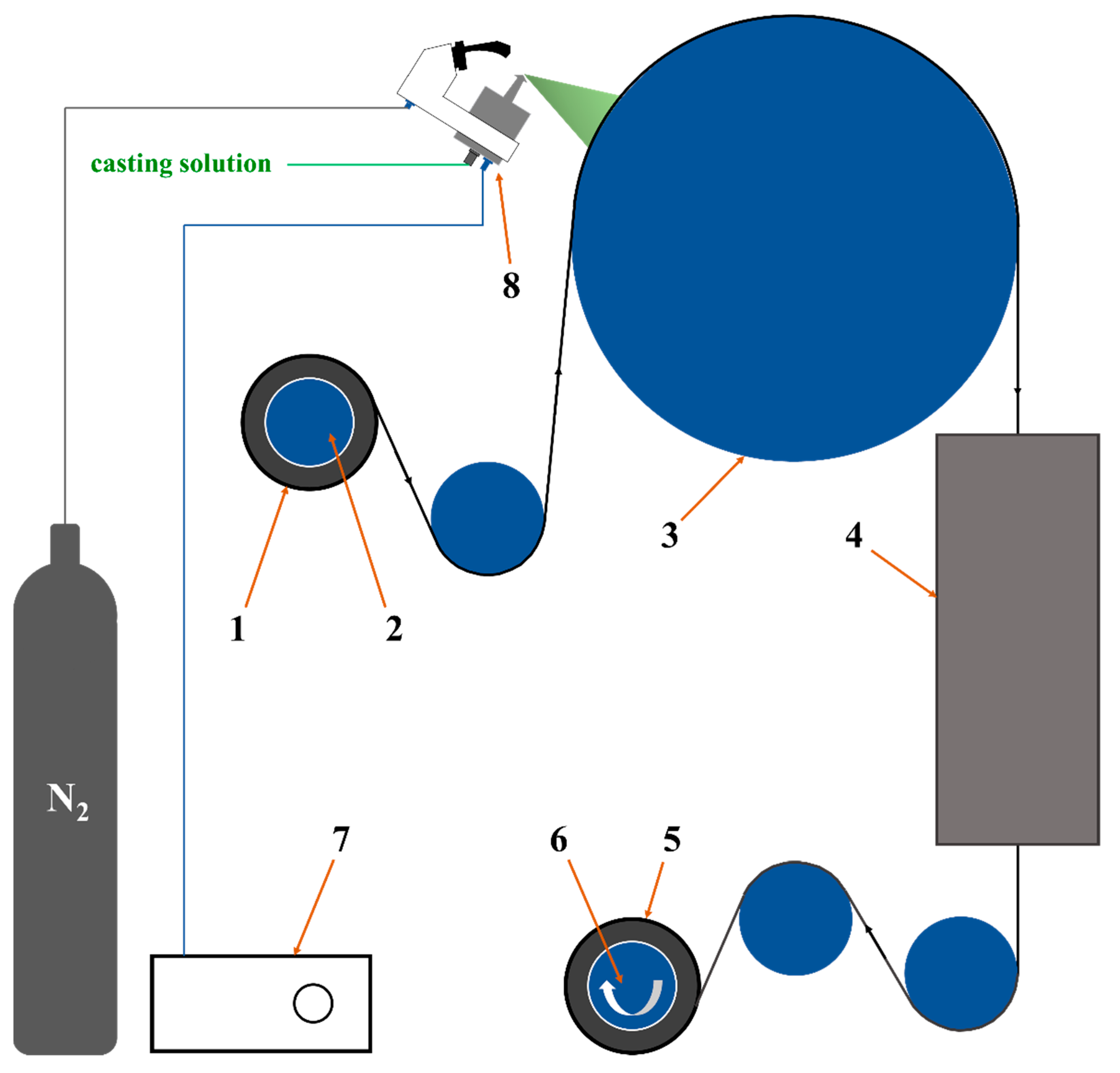

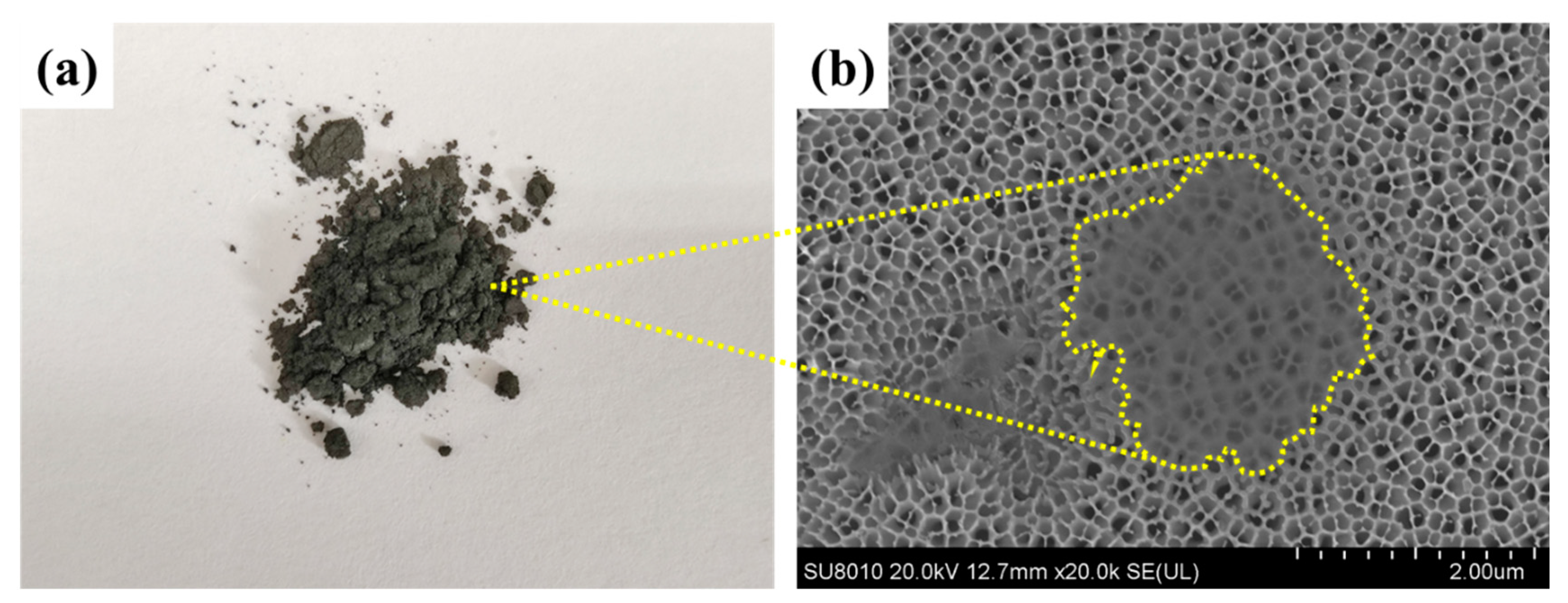
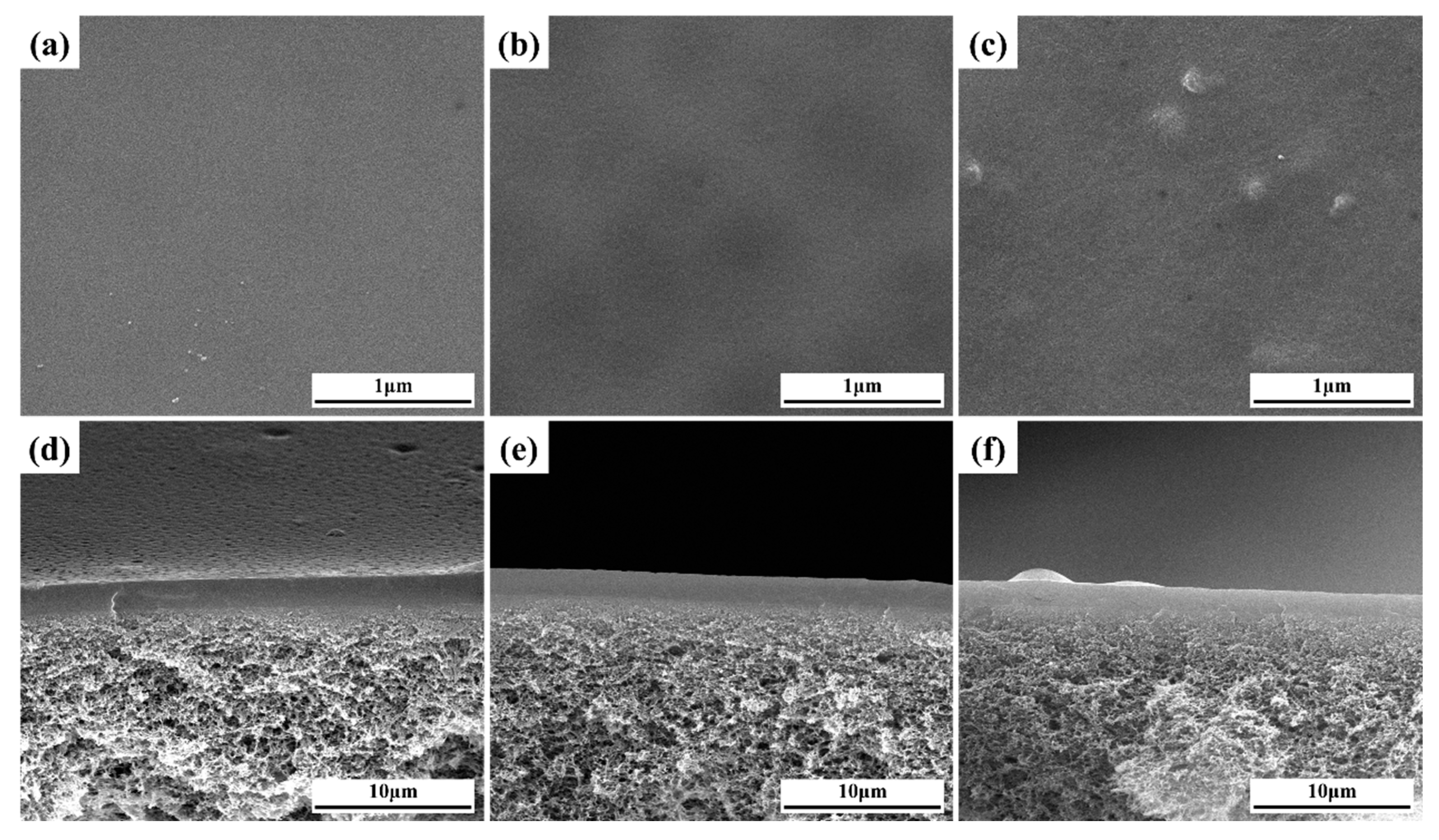


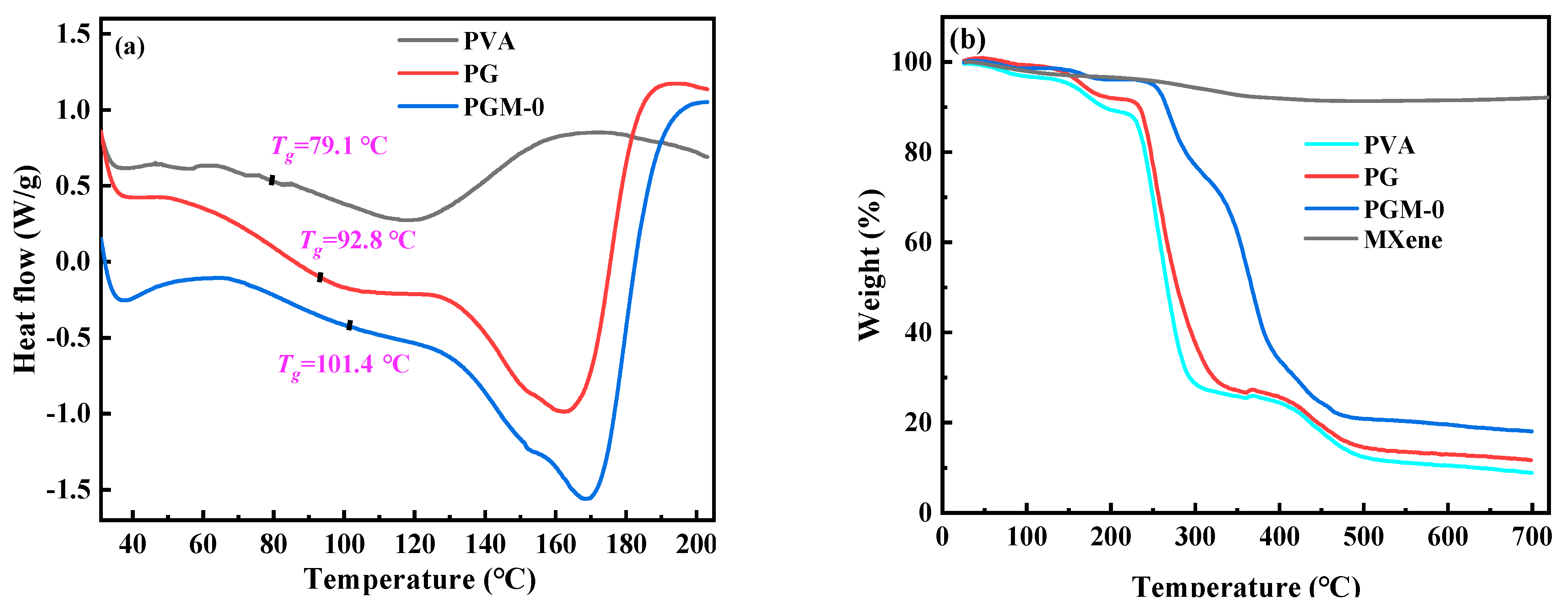

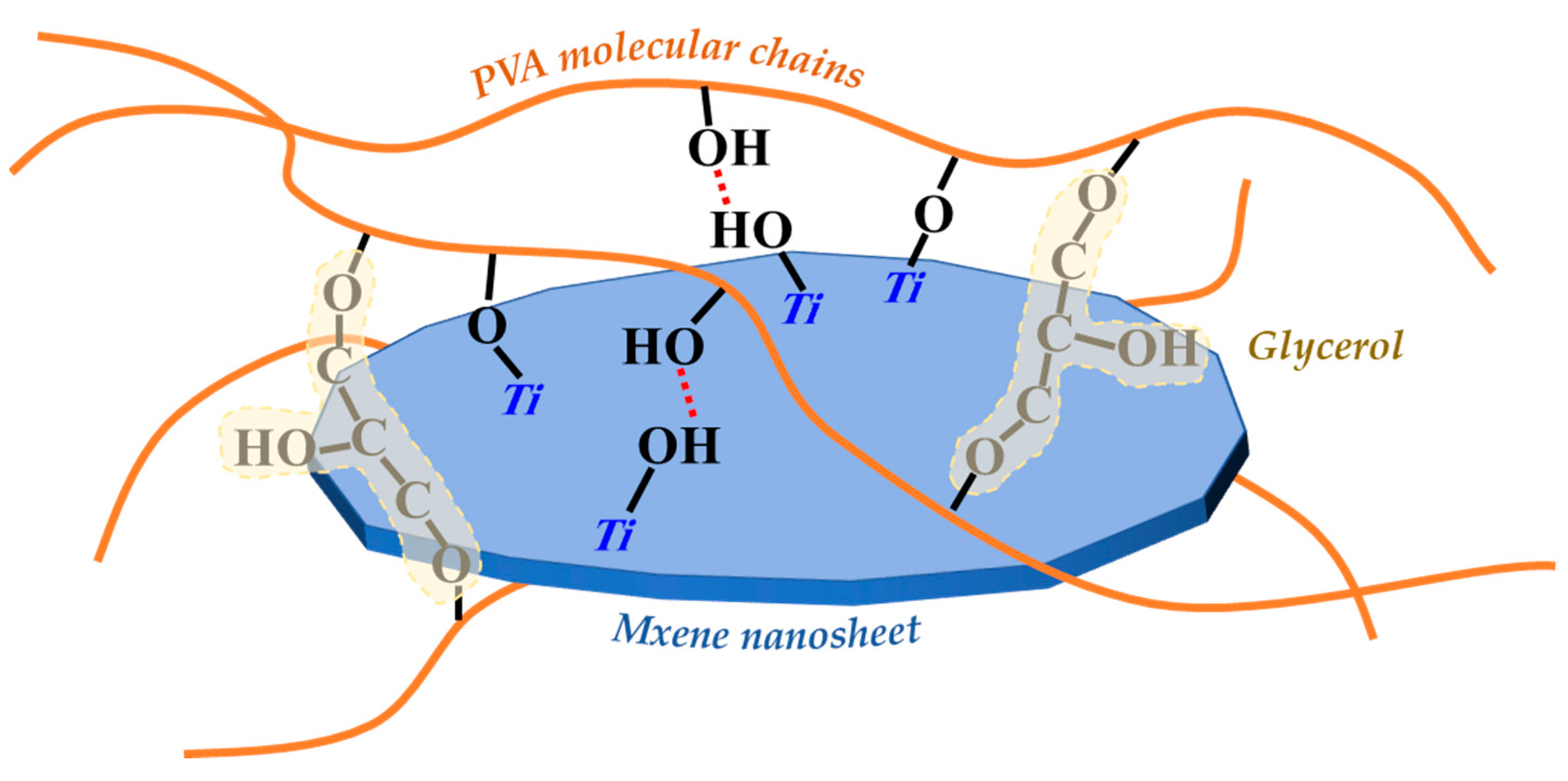
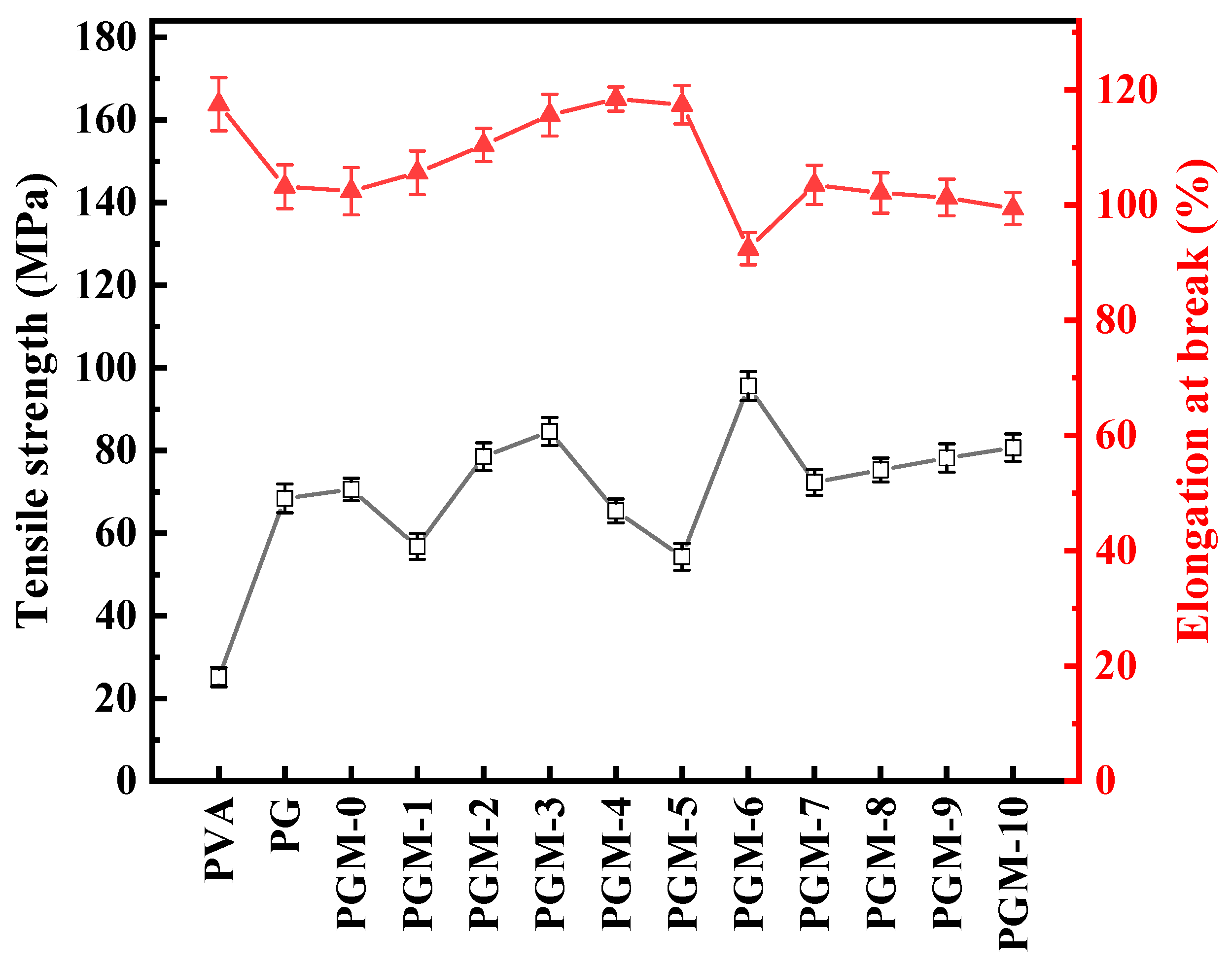
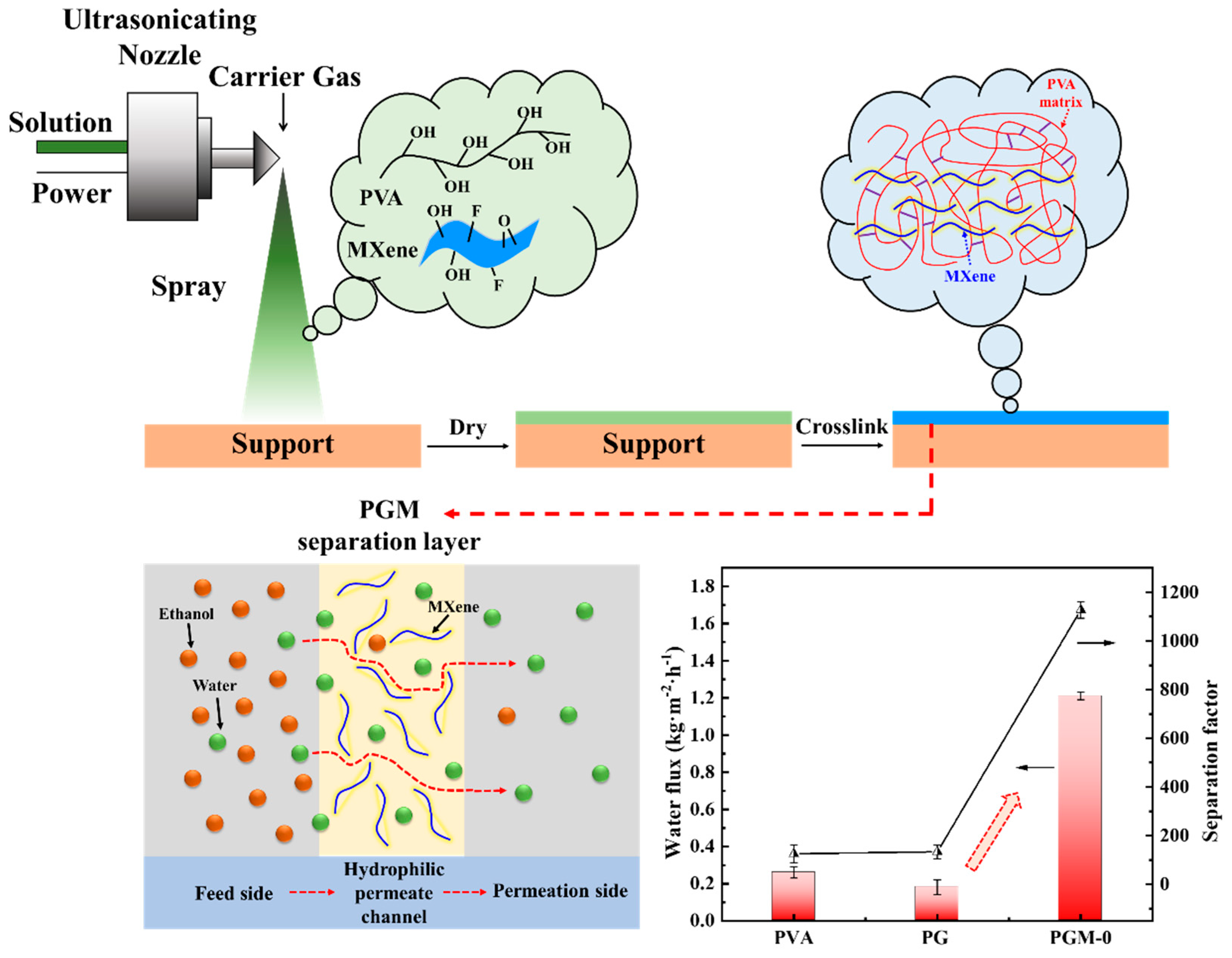


| Membranes (Dense Separation Layer) | Addition Amounts (g) | Support (0.22 μm Pore Size) | |||
|---|---|---|---|---|---|
| PVA | GC | MXene | Water | ||
| PVA | 30 | 0 | 0.0 | 970.0 | PTFE |
| PVA/GC (PG) | 30 | 5 | 0.0 | 965.0 | PTFE |
| PVA/GC/MXene (PGM-0) | 30 | 5 | 1.0 | 964.0 | PTFE |
| PVA/GC/MXene (PGM-1) | 10 | 5 | 1.0 | 984.0 | PTFE |
| PVA/GC/MXene (PGM-2) | 50 | 5 | 1.0 | 944.0 | PTFE |
| PVA/GC/MXene (PGM-3) | 70 | 5 | 1.0 | 924.0 | PTFE |
| PVA/GC/MXene (PGM-4) | 100 | 5 | 1.0 | 894.0 | PTFE |
| PVA/GC/MXene (PGM-5) | 30 | 1 | 1.0 | 968.0 | PTFE |
| PVA/GC/MXene (PGM-6) | 30 | 9 | 1.0 | 960.0 | PTFE |
| PVA/GC/MXene (PGM-7) | 30 | 5 | 0.5 | 964.5 | PTFE |
| PVA/GC/MXene (PGM-8) | 30 | 5 | 1.5 | 963.5 | PTFE |
| PVA/GC/MXene (PGM-9) | 30 | 5 | 2.0 | 963.0 | PTFE |
| PVA/GC/MXene (PGM-10) | 30 | 5 | 3.0 | 962.0 | PTFE |
| Elements | C1s | O1s | Ti2p | ||||||
|---|---|---|---|---|---|---|---|---|---|
| Structures | C-C | C-OH | C-Ti | C=O | O=C | HO-Ti | TiO2 | H2O | Ti-C |
| Peaks (eV) | 284.78 | 285.78 | 287.48 | 288.78 | 532.49 | 533.64 | 531.91 | 534.78 | 459.28 |
| Relative Content (at.%) | 58.00 | 34.99 | 6.06 | 1.22 | 61.42 | 14.82 | 21.26 | 2.50 | 100.00 |
| 71.24 | 26.64 | 2.12 | |||||||
| δd (MPa0.5) | δp (MPa0.5) | δh (MPa0.5) | R0 (MPa0.5) | Ra | RED | |
|---|---|---|---|---|---|---|
| PVA | 17.0 | 9.0 | 18.0 | 4.0 | 25.46 | 6.37 |
| Ti3C2Tx | 18.7 | 15.4 | 14.5 | 11.0 | 28.53 | 2.59 |
| Water | 15.5 | 16.0 | 42.3 | - | - | - |
Disclaimer/Publisher’s Note: The statements, opinions and data contained in all publications are solely those of the individual author(s) and contributor(s) and not of MDPI and/or the editor(s). MDPI and/or the editor(s) disclaim responsibility for any injury to people or property resulting from any ideas, methods, instructions or products referred to in the content. |
© 2023 by the authors. Licensee MDPI, Basel, Switzerland. This article is an open access article distributed under the terms and conditions of the Creative Commons Attribution (CC BY) license (https://creativecommons.org/licenses/by/4.0/).
Share and Cite
Tong, H.; Liu, Q.; Xu, N.; Wang, Q.; Fan, L.; Dong, Q.; Ding, A. Efficient Pervaporation for Ethanol Dehydration: Ultrasonic Spraying Preparation of Polyvinyl Alcohol (PVA)/Ti3C2Tx Nanosheet Mixed Matrix Membranes. Membranes 2023, 13, 430. https://doi.org/10.3390/membranes13040430
Tong H, Liu Q, Xu N, Wang Q, Fan L, Dong Q, Ding A. Efficient Pervaporation for Ethanol Dehydration: Ultrasonic Spraying Preparation of Polyvinyl Alcohol (PVA)/Ti3C2Tx Nanosheet Mixed Matrix Membranes. Membranes. 2023; 13(4):430. https://doi.org/10.3390/membranes13040430
Chicago/Turabian StyleTong, Huijuan, Qiao Liu, Nong Xu, Qing Wang, Long Fan, Qiang Dong, and Aiqin Ding. 2023. "Efficient Pervaporation for Ethanol Dehydration: Ultrasonic Spraying Preparation of Polyvinyl Alcohol (PVA)/Ti3C2Tx Nanosheet Mixed Matrix Membranes" Membranes 13, no. 4: 430. https://doi.org/10.3390/membranes13040430
APA StyleTong, H., Liu, Q., Xu, N., Wang, Q., Fan, L., Dong, Q., & Ding, A. (2023). Efficient Pervaporation for Ethanol Dehydration: Ultrasonic Spraying Preparation of Polyvinyl Alcohol (PVA)/Ti3C2Tx Nanosheet Mixed Matrix Membranes. Membranes, 13(4), 430. https://doi.org/10.3390/membranes13040430







